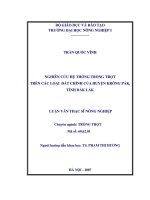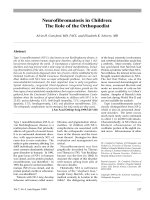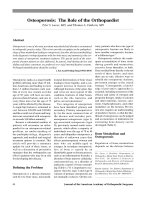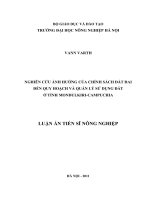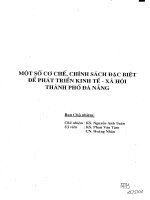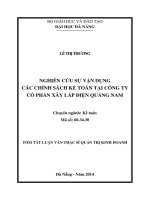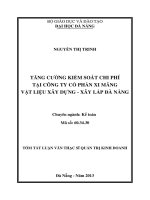Nghiên cứu ứng dụng phẫu thuật nội soi mở ống mật chủ lấy sỏi điều trị sỏi đường mật chính tại bệnh viên đa khoa kiên giang tt tiếng anh
Bạn đang xem bản rút gọn của tài liệu. Xem và tải ngay bản đầy đủ của tài liệu tại đây (329.83 KB, 28 trang )
MINISTRY OF EDUCATION AND TRAINING
MINISTRY OF MILITARY
MILITARY MEDICAL UNIVERSITY
SU QUOC KHOI
APPLIED RESEARCH OF LAPAROSOCPIC
CHOLEDOCHOLITHOTOMY TO TREAT
BILIARY TRACT STONES IN KIEN GIANG
GENERAL HOSPITAL
Speciality: Surgery
Code: 9 72 01 04
SUMMARY OF MEDICAL Ph.D THESIS
HA NOI – 2019
HÀ NỘI-NĂM
THE RESEARCH WORK ACCOMPLISHED AT
MILITARY MEDICAL UNIVERSITY
Scientific supervisors:
1. NGUYEN VAN XUYEN, Ph.D, Assoc.Prof.
2. DANG VIET DUNG, Ph.D, Assoc.Prof.
Reviewer 1: Nguyen Tien Quyet, Ph.D, Assoc.Prof.
Reviewer 2: Nguyen Anh Tuan, Ph.D, Assoc.Prof.
Reviewer 3: Le Trung Hai, Ph.D, Prof.
The Thesis will be defended against the Council of Military
Medical University at:
This thesis can be referred at:
-
National Library of Vietnam
-
Library of Military Medical University
1
INTRODUCTION
Biliary stones is a common disease in Vietnam as well as in the
world. Biliary stones in our country are usually primary stones,
formed in place, in large numbers, large size, many positions, high
rate of intrahepatic stones and recurrence.
Treatment of biliary tract stones has many different methods
but up to now surgery still plays an important role. Currently, in our
country the biliary tract stones are treated mainly by open surgery,
choledocholithotomy and draining Kehr tube.
Laparoscopic surgery is a new revolution in surgery. In 1990,
Stoker
was
the
first
surgeon
to
perform
laparoscopic
choledocholithotomy to treat biliary tract stones. Subsequently, many
reports of Berthou, Grubnik, Petelin ..gave good results, the rate of
stone clearance from 92 to 96.7% with low accidents and complications.
Biliary
tract
stones
in
our
country
have
different
characteristics compared to European - American countries, so even
though laparoscopic surgery has advantages such as less pain, quick
recovery, but application of laparoscopic surgery to treat primary
biliary stones is difficult about indications, surgical technique and
especially being to detect and clean stones. intraoperative
cholangioscopy increases the rate of detecting stones and stone
clearance. However, the applied research of laparoscopic surgery
combining with intraoperative cholangioscopy to to treat bilary tract
stones are few, with a small case volumme. Therefore, much more
research is needed to apply this technique well, especially at the
provincial level, which is difficult due to limitations in equipment,
qualifications and laparoscopic skills. In Kien Giang, laparoscopic
2
surgery for biliary tract stones treatment has not been applied. So we
carry
on
research:
“Applied
research
of
laparosocpic
choledocholithotomy to treat biliary tract stones in Kien Giang
General hospital ” to aim for the following objectives:
1.
Determination of indications and technical characteristics
of laparoscopic choledocholithotomy combined with
cholangioscopy in treating biliary tract stones.
2.
Evaluating the results of laparoscopic choledocholithotomy
combined with cholangioscopy in treating biliary tract
stones at Kien Giang General Hospital.
Some new contributions of thesis:
- Determination of some main indications of laparoscopic
choledocholithotomy combined with cholangioscopy in treating
biliary tract stones.
- Determination of technical characteristics of laparoscopic
choledocholithotomy combined with cholangioscopy in treating
biliary tract stones.
-
Proving
the
safety
and
efficacy
of
laparoscopic
choledocholithotomy combined with cholangioscopy in treating biliary
tract stones: high successful rate, increasing rate of stone clearance.
Frame of thesis
The content of the thesis is presented in 123 pages, including
4 chapters. Introduction in 2 pages. Chapter 1 - Overview in 32
pages. Chapter 2 - Objects and methods in 21 pages. Chapter 3 –
Results in 27 pages. Chapter 4 - Discussion in 31 pages. Conclusion
in 2 pages. Proposal in 1 page. The thesis has 44 tables, 26 images, 6
charts. References in 120 documents.
3
Chapter 1. OVERVIEW
1.4.3. Laparoscopic surgery to treat biliary tract stones
Two main methods of Laparoscopic surgery to remove biliary
tract stones:
+ Transcystic stones extraction
+ Removing stones via choledochotomy.
In addition, some another methods of laparoscopic surgery are
indicated for the treatment of primary biliary stones such as:
laparoscopic liver resection, hepaticojejunostomy...
1.5. Cholangioscopy
1.5.2. Cholangioscopy in laparoscopic surgery to treat biliary
tract stones
Intraoperative cholangioscopy to determine: whether or not
biliary stones remain after removing stones and assess biliary tract, Oddi
sphincter, biliary tract mucosa and we can intervene to clean stones such
as: electrohydraulic lithotripsy, removal stones with basket via
cholangioscopy.
1.5.2.2. Cholangioscopy in laparoscopic surgery
The removal of stones using a tool based on the surgeon's
experience to determine whether or not it has been cleared is
difficult. Using flexible cholangioscopic technique helps overcome
this disadvantage. Cholangioscopy in laparoscopic surgery can
perform transcystic duct or incision of choledochotomy.
In 1990, Stoker performed a flexible cholangioscopy in
laparoscopic surgery for good results.
In 2007, Nguyen Hoang Bac performed intraoperative
cholangioscopy for 167/168 cases, with result detecting 53.6%
4
remained stones after removing stones by instruments.
In 2010, Nguyen Khac Duc performed cholangioscopy for
12/158 cases and determined intraoperative stone clearence. No the
number of these patients has remained stones in postoperative time.
Cholangioscopy not only diagnoses remnant stones but also
helps surgeons choose and use measures to take stones such as using
basket, lithotripsy, tools, washing... to lower the rate of postoperative
retained stones. Besides, cholangioscopy as a means to help surgeons
to identify intraoperative stone clearance, bile duct mucosa and
narrowed bile ducts, thereby deciding to close common bile duct.
1.6. Laparoscopic surgery to treat biliary tract stones in the world
The main biliary stones in Western countries are usually
secondary stones, from the gallbladder falling down, so the stones are
usually small, not many tablets, usually common bile duct stones
combine with gallstones, stones in low section of CBD and no
intrahepatic stones, so transcystic stone extraction is very high, 50.482.5%. In contrast, Asian authors have a lower rate of transcystic
stone extraction.
The research and application of laparoscopic surgery to treat
biliary tract stones have made much more progress and indication to
have been expanded. In addition, many studies have control groups to
determine the advantages of laparoscopic surgery treating biliary
tract stones were perfomed.
The main biliary stones in Western countries are usually
secondary stones, small size, not many tablets, usually common bile
duct stones combine with gallstones and no intrahepatic stones.
Intraoperative cholangioscopy to detect, remove stones or lithotripsy
is performed routinely and almost 100% of cases of laparoscopic
5
surgery. However, cholangioscopic scope can be performed by
specialized flexible scope, rigid endoscopic scope, uterorenoscope or
bronchoscope.
1.7. Laparoscopic surgery to treat biliary tract stones in Viet Nam
In 1999, the hospital of Ho Chi Minh City University of
Medicine and Pharmacy performed laparoscopic surgery to treat
biliary tract stones by technique using intraabdominal air insufflation
and extract stones via transcystic duct and choledochotomy.
Table 1.6. Laparoscopic surgery to treat biliary tract stones in
Viet Nam
Author
n
Success (%) Complication (%)
Nguyen Hoang Bac (2007) 168
97,7
6,4
Nguyen Khac Duc (2010) 128
86,49
3,9
99
7,6
Tran Manh Hung (2012)
105
It can be said that since 1998 up to now, the laparoscopic
surgery for biliary stones treatment consist of 3 main studies, which
are indicated for cases, using many techniques to treat stones.
Regarding indications, there are many different indications:
Nguyen Hoang Bac, Nguyen Khac Duc indicate for reoperative cases
but the number of authors is only 15 cases; indications for
extrahepatic stones are performed by Nguyen Hoang Bac, Nguyen
Khac Duc, Tran Manh Hung. Nguyen Hoang Bac appointed for cases
of simple choledocholithiasis with size of stone ≥ 20mm. Nguyen
Khac Duc, Tran Manh Hung only required stone diameter from 8mm
to10mm.
Indications
of
laparoscopic
surgery
for
simple
choledocholithiasis, failure of ERCP were performed by 3 authors
6
but in few numbers. Besides, Nguyen Hoang Bac also indicated for
intrahepatic stones with a low rate of 33.1%.
Technical characteristics: Nguyen Hoang Bac performed the
removal of stone through cystic duct with the number of 10 cases and
through choledochotomy, hepatectomy to intrahepatic stones.
Nguyen Khac Duc and Tran Manh Hung only performed
choledocholithotomy for extrahepatic biliary tract stones. Regarding
primary closure, no bile drainage was conducted by all 3 authors. In
terms of cholangioscopy combined with laparoscopic surgery: Tran
Manh Hung did not perform, Nguyen Khac Duc, Nguyen Hoang Bac
did not perform all cases due to a broken scope. This is one of the
general limitations of studies.
Surgical results when pooled analysis including cases of
internal and extrahepatic stones, first surgery and reoperation,
transcystic stone extraction and choledocholithotomy, drainage and
none drainage: Laproscopic surgery to treat biliary tract stones has a
success rate ranging from 86.5% to 99.0%. The rate of converting to
open surgery varies from 1% to 13.5%. Intraoperative accidents 1.2 2.75%. Postoperative complications 3.91 - 7.6%.
The characteristics of biliary stone in Vietnam are different
from
those
of
Europe
and
America.
The
author
choose
choledocholithotomy instead of removing stones through cystic duct.
laparoscopic surgery has many advantages, but it is necessary to
combine intraoperative cholangioscopy to increase the efficiency of
stone clearance. However, at present, there are few studies evaluating the
method of laparoscopic surgery combining with intraoperative
cholangioscopy to treat main biliary tract stones. This is an urgent need,
contributing to improving treatment effectiveness so we do this research.
7
Chapter 2. SUBJECTS AND METHODS
2.1. Subjects
Subjects are patients that have biliary tract stones treated by
laparoscopic
choledocholithotomy
at
the
General
Surgery
Department of Kien Giang General Hospital from 2014 to 2018.
2.1.1. Inclusion criteria
Patients with main biliary tract stones include patients with
recurrent stones (reoperation) diagnosed surely and determined
location of stones, size of stones and bile ducts by pre-operative
computerized tomography. Select the following cases:
+ Simple choledocholithiasis: Choose cases with diameter of
choledocholithiasis ≥ 20mm or preoperative ERCP failed .
+ Cholecysto-choledocholithiasis
+ Choledocholithiasis combines with intrahepatic stones with or
without choledolithiasis
2.1.2. Exclusion criteria
- Age < 18 years old.
- Diameter of choledocholithiasis determined on CT < 10mm
- Patient have stones in biliary tract cyst
- Simple intrahepatic stones, no choledocholithiasis.
- Contraindication of laparoscopic surgery: coronary artery disease,
respiratory failure...
2.2. Methods
2.2.1. Study design
A prospective descriptive study with longitudinal follow and uncontrol
2.2.2. Sample size
Sample size is calculated by the following formula:
8
n ≥ Z2(1- α/2) p(1-p)/d2
Confidence interval: 95%, Z = 1,96; d = 0,05
p: Success rate of laparoscopic choledocholithotomy 86,5 - 97,7% [10],
[14], [67]. We choose p = 0,95 (95%)
The number of patients needed to research at least 73.
2.2.4. Technique
- Endotracheal anesthesia. Patient supine
- Surgeon and camera man standing on the left, assistants
standing on the right
Main steps of laparoscopic surgery:
Step 1: Đặt trocar, Air insufflation
Step 2: Investigate the abdominal cavity
Step 3: Exposure and choledochotomy
Step 4: Removing stones
Step 5: Cholangioscopy
Step 6: Cholecystectomy when indicated
Step 7: Place the Kehr tube
Step 8: Hoàn thành cuộc mổ
2.2.6. Researching on indications
+ Ratio of first surgery or biliary tract stones reoperation
+ Ratio of simple choledocholithiasis
+ Ratio of cholecysto-choledocholithiasis
+ Ratio of choledocholithiasis combines with intrahepatic stones
+ Ratio of patients ≥ 70 and < 70 years old
+ Ratio of preoperative ERCP failed.
Comparison between groups on operative time, flatus time, pain
relief, hospital stay time and rate of stone clearance.
9
2.2.7. Intraoperative researching: technique of laparosopic surgery
* Patient posture and trocar placement
* Investigate the abdominal cavity:
+ Diameter of CBD
+ Choledocholithiasis or no choledocholithiasis
+ Investigate gall bladder with inflamation, stones.
+ Investigate liver stalk with or without adhesion
+ In the case of abdominal surgical scar: not adhesion, little
adhesion, a lot of adhesion in abdominal wall, the liver stalk.
*Choledochotomy technique: vertical or horizontal incision, location.
*Method to remove stones
Assess advantages, disadvantages of technique and stone
extraction method.
*Check stone clearance and clean of biliary tract
- Cholangioscopy with or withou retained stone?Management, result?
* Biliary tract drainage: T-tube drainage or closure
*Intraoperative accidences: Bleeding, duodenal perforation...
*Converting to open: ratio, causes?
*Calculating operative time
2.2.8. Researching surgical results
+ Success ratio
+ Note time that patient can eat, drink, flatus.
+ Note time using pain relief drug
+ Note postoperative dysfunction
+ Postoperative complications
+ Hospital stay time
+ Result of postoperative ultrasound, cholangiography via T-tube
+ Location of residual stones
10
+ Managing residual stones: Lithotripy, ERCP, observation.
+ Ratio of stone clearance. Determining stone clearance base on 3
following factors that all are clear:
Cholangioscopy
Postoperative ultrasound without stones
Cholangiography via T-tube without stones
+ Recurrence, recurrence time?
* Assess result of laparoscopic surgery:
- Postoperative early results
+ Good: The patient was examined postoperative biliary tract,
which showed that stones was cleaned.
+ Medium: The patient is stable, the biliary tract remains stones.
Removing stones through Kehr tunnel or ERCP are required. There
are complications (except surgical infections) but medical treatment
is stable, not sequelae.
+ Bad: Occurrence of complications must reoperate or die.
- Long term result
+ Good: A healthy patient returns to his previous job. Ultrasound or
computerized tomography does not recur stones.
+ Medium: patients does not returns to his previous job. Ultrasound
or computerized tomography has recurrence but not requiring
reoperation or only ERCP required.
+ Bad: Ultrasound or computerized tomography has recurrence
requiring reoperation, death due to disease of biliary tract.
2.2.9. Methods of processing and analyzing data
The data is collected by sample records, then the variables are
encrypted and entered into the computer. All statistical analyses were
performed using SPSS 20.0 software.
11
Chapter 3. RESULTS
3.1. Common characteristics
3.1.1. Age and gender
- Total number of patients: 103 cases
- Gender: Male 35/103 patients; Female 68/103 patients ;
- Male / female ratio:
2/1
- The average age : 56,2 ± 14,9 (24 - 89) years old.
3.1.3. History
History of abdominal surgery: 41/103 cases, equal to 39,8%.
3.2. Indication, techniqual characteristics, results of laparoscopy
103 cases were operated, 3 cases converting to open surgery
So total of laparosopic surgery were 100 cases
Table 3.18. Methods of laparosopic surgery
Surgical methods
n =100 Ratio (%)
Choledocholithotomy, T- tube drainage
Choledocholithotomy, cholecystectomy, Ttube drainage
Total
54/100
54,0
46/100
46,0
100
100,0
3.2.1. Indications of laparoscopic surgery
- Reoperative ratio: 36% cases, first surgery 64% cases
- Patients > 70 years old: 20% cases, < 70 years old: 80% cases
- Pre-operative ERCP to remove stones failed: 7/100(7%) cases
- Location of stones:
+ Simple choledocholithiasis:
+ Cholecysto-choledocholithiasis:
25/100(25%) cases
22/100(22%) cases
+ Choledocholithiasis, intrahepatic stones: 53/100(53%) cases
- Extrahepatic stones:
47/100(47%) cases
12
- Choledocholithiasis, intrahepatic stones:
53/100(53%) cases
3.2.2. Techniqual characteristics of laparoscopic surgery
100% Patient supine, surgeon standing on the left
100% Placing 4 trocars
100% Vertical choledochotomy
100% T- tube drainage
100% Removing stones by instruments and washing
100% Having intraoperative cholangioscopy
100% Interrupted suture to close CBD, using Viryl 3.0.
3.2.3. Results of laparoscopic surgery
3.2.3.1. Cholangioscopy in laparoscopic surgery
*Determining retained stones, stone clearance:
Bảng 3.19. Results of cholangioscopy in laparoscopic surgery
Intraoperative cholangioscopy
Number (n=100)
Ratio (%)
Detect retained stones
57/100
57,0
Stone clearance
43/100
43,0
100
100,0
Tổng
- Comparing the ratio of residual stone after removing stones with
tools in the first surgical group (54.7%) was lower than reoperative
group (69.4%) but the difference was not statistically significant with
p = 0.533 according to Chi squared test.
- Comparison of the rate of residual stone detected by
cholangioscopy in intrahepatic stone group (84.5%) was higher than
extrahepatic stones group (25.5%) and the difference was statistically
significant with p = 0,000.
* Managing retained stones were detected by cholangioscopy:
32/57(56,1%) cases have intraoperative electric hydraulic lithotripsy.
13
Table 3.24. Results of managing retained stones were detected by
intraoperative cholangioscopy
Results
n = 57
Ratio (%)
42/100
42,0
Knowing retained stone
12/100
12,0
True retained stone
3/100
3,0
57
57,0
Stone clearance
Retained stone
Tổng
3.2.3.2. Operating time
Mean operating time: 139,3 ± 50,0 (55-275) minutes
-The operating time of reoperative group is longer than the first
surgery group and difference is statistically significant with p <0.0001
-The operating time of intrahepatic stone group and the extrahepatic
stone group is statistically significant difference with p = 0.001.
-The operating time of cholecystectomy and non cholecystectomy
group is not statistically significant difference with p = 0.467.
-The operating time of intraoperative lithotripsy group and the nonlithotripsy group is statistically significant difference with p = 0.001.
3.2.3.3. Conversion to open surgery
3/103(2,9%) cases converting to open
3.2.3.4. Intraoperative accidences
4/103(3,9%) cases have intraoperative accidences
3.2.3.5. Postoperative complications
4/100(4,0%) cases have postoperative complications
2(2%) abdomial pain after T-tube removal.
2(2%) surgical infection
3.2.3.6. Flatus time
Mean: 1,6 ± 0,7(1-4) days. 93% are in the first 2 days after surgery.
14
- Flatus time in the group of patients 70 years and the group < 70
years old is not statistically significant difference with p = 1,000.
-Flatus time in the group of first surgery and reoperation is not
statistically significant difference with p = 571.
- Flatus time of intrahepatic stone group and the extrahepatic stone
group is statistically significant difference with p = 0.964.
-Flatus time of intraoperative lithotripsy group and the nonlithotripsy group is statistically significant difference with p = 0.650.
3.2.3.7. Pain relief
The average time using pain relief by injection: 3,6 ± 1,5(1 - 7) days
The duration of analgesic use between the group <70 years and ≥ 70
years is not statistically significant with p = 0.160 t - test.
-The duration of analgesic use between the first surgery and
reoperation was not statistically significant with p = 0.943 in t - test.
-The duration of analgesic use between extrahepatic stone and
intrahepatic stone group is not statistically significant with p = 0.811.
-Duration of analgesic use between intraoperative lithotripsy and
non-lithotrypsy group is not statistically significant with p = 0.802.
3.2.3.8. Stone clearance result
83/100(83%) cases are stone clearance (postoperative stone
clearance) being determined by cholangioscopy, ultrasound, and
cholangiography via Kehr. Intraoperative cholangioscopy increased
the rate of stone clearance all patients from 41% to 83%.
Intraoperative cholangioscopy increased the rate of stone
clearance of extrahepatic stone group from 74.5% to 95.7%.
Intraoperative cholangioscopy increased the rate of stone
clearance of intrahepatic stone group from 15.5% to 71.7%.
The first surgery group had a higher rate of stone clearance than
15
reoperative group but difference are not statistically significant, p = 0.626.
3.2.3.9. Ratio of residual stones
Ratio of postoperative residual stones is 17%. Including:
knowing retained stone is 12% and true retained stone 5(5%) cases.
3.2.3.10. Postoperative hospital stay
Average length of hospital stay: 10.5 ± 2.7 days. 94% cases 14 days
- Hospital stay time in the group 70 years and the group < 70 years
old is not statistically significant difference with p = 0.086.
-Hospital stay time of extrahepatic stone and intrahepatic stone group
is not statistically significant difference with p = 0.610. .
-Hospital stay time of intraoperative lithotripsy and non-lithotripsy
group is not statistically significant difference with p = 0.146.
3.4. Assess early results
Table 3.33. Postoperative results
Result
n=100
Tỷ lệ %
Good
81
81,0
Medium
19
19,0
Bad
0
0
Total
100
100,0
3.5. Assess long-term results
Table 3.34. Long term results
Result
n = 100
Ratio %
Good
88
88,0
Medium
11
11,0
Bad
1
1,0
Total
100
100,0
16
Chapter 4. DISCUSSION
4.2. Discussing indications
4.2.2. Indicating laparoscopic surgery instead of ERCP
* Cholecysto-choledocholithiasis
Cases
of
cholecysto-choledocholithiasis
if
laparoscopic
cholecystectomy and ERCP are performed, and the patient must be at
the same time with 2 risk groups of laparoscopic cholecystectomy
and ERCP. Therefore, it is necessary to consider when choosing the
intervention method. Do Trong Hai recommends that for cases of
cholecysto-choledocholithiasis it is necessary to choose the technique
that surgeon have experience to be safe for patients.
We have 22 cases of extrahepatic stones: cholecystocholedocholithiasis to be performed laparoscopic choledocholithotomy
and cholecystectomy with good results.
*Simple choledocholthiasis
According to the guidelines for the treatment of the CBD stones
of the American Endoscopic Society, diameter of stone > 15mm is a
difficult prognostic factor, reducing the success rate and to be
combined with other methods such as mechanical lithotripsy.
Especially the case of very large stones, > 20mm is a predictor of
ERCP failure and complications of mechanical lithotripsy 6 - 13%
[87]. We carried out laparoscopic surgery for 26 cases of simple
choledocholithiasis with diameter of stone ≥ 20mm with good results.
4.2.3. Laparoscopic indication for choledocholithiasis combining
with intrahepatic stone
We successfully performed laparoscopic surgery with intrahepatic
stone 53% and more than Nguyen Hoang Bac’ study, 33.1%
The operating time in the intrahepatic stone group was longer
17
than the extrahepatic stone group, which was statistically significant
but in terms of flatus time, duration of pain relief, hospital stay time
are not statistically significant difference. Laparoscopic surgery for
cases of intrahepatic stone, if there is a combination of intraoperative
cholangioscopy to remove stones and lithotripsy increasing rate of
stone clearance from 15.5% to 71.7%.
4.2.4. Laparoscopic indication for preoperative ERCP failed
We have 7 (6.8%) cases indicated laparosocopic surgery due to
preoperative ERCP failed. In which, 4 cases with large stones could
not be obtained, 2 cases due to diverticulum, one case was caused by
basket trapped and broken. In case of trouble we had emergency
surgery. Postoperative results are stable and discharge after 8 days.
We found that the application of labaproscopic surgery for cases of
preoperative ERCP failed is safe, highly successful rate.
4.2.5. Laparoscopic indication for reoperation and abdominal scar
In our study, there were 41 cases with a history of abdominal
surgery with surgical scar on the navel, under the umbilicum,
endoscopic surgical scar including 2 cholecystectomy and 39 cases of
biliary tract reoperation (once: 29 cases, 2 times: 5 cases and 3 times:
5cases). The rate of biliary tract reoperation was successfully
performed 36/39 (92.3%) cases.Although the surgery time is longer,
there is no statistically significant difference between the first
operative group and reoperative group about rate of residual stone
that is dectected by intraoperative cholangioscopy, the rate of
postoperative stone clearance, the rate of postoperative residual
stone, duration of pain relief, length of hospital stay and no death.
The indication of laparoscopic surgery for treating biliary tract stone
we have identified with Nguyen Hoang Bac: indication of
18
laparoscopic surgery to treat biliary stones without considering
whether the patient has biliary surgery or not.
4.2.6. Laparoscopic indication for elderly patient
Our study, the average age: 56.2 ± 14.9 years, the youngest age
is 24 years old, the largest is 89 years old. In particular, patients older
≥ 70 years old have 20.4%. Comparing between ≥ 70 and <70 years
old group was no statistically significant difference in flatus time,
pain relief, hospital stay time and no case of death.
4.3. Regarding characteristics of laparoscopic surgery combining
with intraoperative cholangioscopy
4.3.1. Posture of patient and postion of surgeon
We performed all cases of posture of supine patients, surgeons
standing on the left side of the patient and not having difficulty in
carrying out the operation, removing choledocholiththiasis or
intrahepatic
stones,
closing
CBD.
Especially
manipulating
cholangioscopy smoothly, without changing the position of surgeon.
4.3.2. Placing trocars
We found that placing 4 trocar was reasonable and performed most
of the cases and there was no need to place more trocar. The problem
of old abdominal surgical scar places trocar in located 2-5cm from old
surgical scar and trocar placement technique by Hasson’s method.
3.3. Adhesiolysis
Experience of using scissor to dissect is more subtle and easy,
limiting using of electric hook, harmonic scapels to avoid organ injury.
4.3.4. Choledochotomy
In our study, 100% TH opened in the front position, opened
vertically in the bile duct. If only the extra-hepatic stone is present, the
site of choledochotomy is close to lower
duodenum. If there is
19
intrahepatic stone, choledochotomy is close to the biliary tract junction
4.3.5. Stone removal
After choledochotomy, we withdraw the trocar in the right upper
quadrant, through this trocar hole, we put Randall into CBD to check
and remove stone. In our studies. All cases are needed to use this
classic tool to extract stones.
4.3.6. Intraoperative cholangioscopy
4.3.6.1. Detecting stones and determing stone clearance
After the surgeon took the stones with tools and assessed that the
stones had been removed all, cholangioscopy showed that the stones
were cleared with only 43.0% and detecting stones accounts for 57, 0%.
However, in 43 endoscopic cases without stones, but postoperative
examination found 2 more cases of remnants by ultrasound stones. So if
cholangioscopy is not used in surgery, the rate of stone clean is low, only
41.0% cases. Nguyen Hoang Bac’study: intraoperative cholangioscopy
identified only 46.4% of stone clearance and helped detecting 53.6%
cases
of
residual
cholangioscopy
has
stone. According to Vindal
more
advantages
than
intraoperative
intraoperative
cholangiography on the determination of stone clearance in laparoscopic
choledocholithotomy. Besides, intraoperative cholangioscopy is also less
time-consuming, less difficult and does not have false positives as
intraoperative cholangiography. Cholangioscopy is considered as a
standard technique to identify stone clearance in laparoscopic
choledocholithotomy.
4.3.6.2. Lithotrypsy and stone extraction by cholangioscopy
We had 57 cases of intraoperative cholangioscopy with 32/57
(56.1%) cases having hydroelectric lithotripsy. Intraoperative
cholangioscopy increased the rate of stone clearance of extrahepatic
20
stone from 74.5% to 95.7% and intrahepatic stone from 15.5 % up to
71.7%. Intraoperative lithotripsy despite prolonging the operative
time compared to the group without lithotripsy was statistically
significant. However, there was no statistically significant difference
in flatus time, duration of pain relief, hospital stay time.
4.3.7. Regarding of leaving stones
We actively remove stones in surgery as much as possible.
Because if you try to get a stone in surgery, it will increase the rate of
stone clearance and the need for postoperative lithotripsy will be less.
Therefore, rate of residual stone is only 17% lower than Nguyen
Hoang Bac's study, 28.6%. In our study, need for lithotripsy is 1,4 (12) times of gravel. Nguyen Hoang Bac’study is 2,28 (1-6) times.
4.3.8. Biliary tract drainage
The difficult problem in biliary stone surgery is determing
stone clearance, thereby deciding to close or drain the bile ducts. The
placement of Kehr drainage is essential to check stone clearance and
residual stone after surgery and thereby lithotripsy via Kehr unnel,
so we set routine bile drainage, 100% cases.
4.4. Result of laparoscopic surgery
3.4.1. Operating time
The average operative time in our study for 100 cases of successful
laparoscopic surgery is: 139.3 ± 50.0 minutes. The reoperative group,
intraoperative lithotripsy and the intrahepatic stone group had longer
surgical time than the first operative group, non-lithotripsy group,
extrahepatic stone group were statistically significant. However, there
was no statistically significant difference in the surgical time between
cholecystectomy group and group without cholecystectomy.
4.4.2. Postoperative recovery
21
The flatus time between the group over 70 years old and the group
less than 70 years old, the first operative group and the reoperative
group, the intraoperative lithotripsy and non-lithotripsy group, the
extrahepatic stone and intrahepatic stone group are not statistically
significant difference in t - test.
The average duration of pain relief is 3.6 ± 1.5 days. Time to use
analgesia between group ≥ 70 years and group <70 years old, the first
operative group and the reoperative group, the intraoperative lithotripsy
and non-lithotripsy group, the extrahepatic stone and intrahepatic stone
group are not statistically significant difference in t - test.
4.4.3. Success rate
The surgery is considered successful when performed by
laparoscopic surgery from beginning to end. Our success rate is 97.1%.
4.4.4. Conversion to open
In the study, we have 3 cases converting to open surgery. The
cause is due to intraoperative accident, so it has to be switched to
open surgery to manage. These are difficult cases, reoperative caes
with many times.
4.4.5. Accidents, complications
04 (3.9%) cases had intraoperative accidents including
bleeding, duodenal perforation, duodenal laceration. These are biliary
tract stone reoperation. Stable postoperation.
4(4,0%) cases had postoperative complications including 02
cases with pain after T-tube removal and 02 cases with surgery
infections. Hospital discharge and re-examination are stable.
4.4.6. Residual stone
We had all 17 cases of residual stone after surgery including: 5
cases of true stone remaining and 12 cases of knowing residual stone
22
in surgery due to leaving stones. Ratio of residual stone in our study
is higher than that of Nguyen Hoang Bac but lower than Nguyen
Khac Duc and Le Quoc Phong’ study.
4.4.7. Ratio of stone clearence
Determination is
postoperative stone clearance based on
cases of intraoperative cholangioscopy, ultrasound, postoperative
cholangiography via Kehr that all are stone clearance. The rate of
postoperative stone clearance of laparoscopic surgery combining with
surgical laparoscopy is 83%. Comparing the rate of postoperative
stone clearance, the extrahepatic stone was 95.7% higher than
intrahepatic stone with stone clearance was 71.7% and difference was
statistically significant. The rate of postoperative stone clearance of
the first operative group was higher than reoperative group: 84.4%
compared to 80.6% but difference was not statistically significant.
4.4.8. Hospital stay time
Average length of hospital stay: 10.5 ± 2.7 days. Hospital
stay time in the group of patients <70 years and the group of ≥ 70
years old, the group had the first surgery and the biliary reoperation,
the group of extra-hepatic stones and intrahepatic stone, the group
had intraoperative lithotripsy and no lithotripsy are not statistically
significant difference according to t-test.
4.6. Assess result
Postoperative eraly result: good 81%, medium 19%, no bad.
Nguyen Khac Duc : good 86,7%, medium 9,4% and bad 3,9%.
Long term result: good 88%, medium 11% and bad 1%
(reoperating due to recurrence). Nguye Khac Duc ‘s study with long
term result: good 80,4%, medium 19,6%.
23
CONCLUSION
Through
103
cases
of
laparoscopic
choledocholithotomy
combined with cholangioscopy in treating biliary tract stones at Kien
Giang General Hospital, we have some following conclusions:
1. Indications and technical characteristics of laparoscopic
choledocholithotomy combined with cholangioscopy in treating
biliary tract stones.
Indications:
- Indication for young and elderly patients: 24-89 years old.
- Indication for biliary tract stones (64%) and recurrence biliary tract
stones (36%).
- Indication for simple choledocholithiasis with diameter of stone ≥ 20mm.
- Indication for simple choledocholithiasis, ERCP failed.
- Indication for choledocholithiasis combines with cholelithiasis.
- Indication for choledocholithiasis combines with intrahepatic stones
(53%).
Technical characteristics:
- Posture of patient and surgeon: supine patients, surgeons standing
on the left side of the patient can perform surgery well.
- Placing trocar: using 4 trocar is reasonable, safe. In the case of
abdominal surgical scars, Trocar must be located away from the old
incision and using Hasson’s technique.
- Adhesiolysis: using scissor instead of electric hook to dissect will
be more subtle and easy.
- Vertical choledochotomy, the site of choledochotomy is close to
lower duodenum for extra-hepatic stone. If there is intrahepatic stone,
choledochotomy is close to the biliary tract junction requiring diameter


